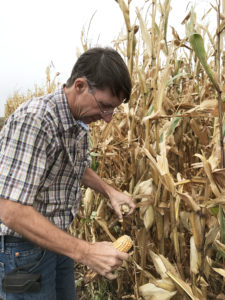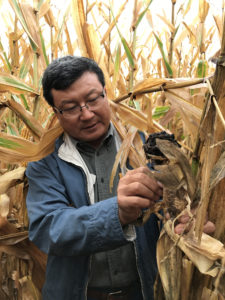Farm & Ranch
[AgriLife Today] AgriLife experts discuss fumonisin contamination, possible avoidance practices

By: Kay Ledbetter
Writer: Kay Ledbetter, 806-677-5608, [email protected]
Contact: Dr. Tom Isakeit, 979-862-1340, [email protected]
Dr. Wenwei Xu, 806-746-6101, [email protected]
AMARILLO – Texas A&M AgriLife officials are offering some best management practices for producers to keep in mind as harvest continues and for next year after fumonisin contamination has been found in truckloads of corn across the Texas High Plains.

Dr. Tom Isakeit, Texas A&M AgriLife Extension Service plant pathologist in College Station, spent several days collecting samples in the High Plains for fumonisin contamination testing. (Texas A&M AgriLife photo by Dr. Jourdan Bell)
Dr. Tom Isakeit, Texas A&M AgriLife Extension Service plant pathologist in College Station, said this year nothing can be done to minimize fumonisin already present in the standing crop; however, producers can make a few changes during harvest to possibly reduce the amount of contaminated grain collected.
“You can adjust the combine settings to kick out the smaller grain kernels that tend to have much higher levels of contamination of fumonisin,” Isakeit said.
Fumonisin toxin is produced when certain Fusarium fungi are present on the corn, although not all Fusarium-infected kernels will have fumonisin, he said. The only way to know if the toxin is present is to have a chemical test run.
But there are visible symptoms of the fungal infection, including a white discoloration of the kernels, and when they dry down they will be smaller or lighter than the healthy kernels, Isakeit said.
The severity can be lessened by cleaning the seed or separating the damaged kernels out, he said. Sometimes just a few kernels can cause the higher concentrations. And though it is not done much in Texas, artificially drying the corn from a high moisture of 24 percent to 15 percent in a 24-hour period can also minimize contamination. Optimum levels of fumonisin production occur between 18-20 percent moisture.
Also, producers should segregate portions of the field if there was moisture stress, keeping corn from the drought-stressed areas of the field separate from the rest of the field, Isakeit said.
“The worst damage generally occurs around the edges of the field,” he said. “What you find on the outside for fumonisin contamination might not be what you find in the middle of the field.”

Dr. Wenwei Xu, Texas A&M AgriLife Research corn breeder in Lubbock, examines a field of corn in the southern High Plains of Texas for Fusarium fungus disease. (Texas A&M AgriLife photo by Dr. Jourdan Bell)
Isakeit also warned that putting corn into storage won’t get rid of the fumonisin contamination, but high levels of moisture or some leakage after placement in bins can add to the problem.
“For storage, you want to have your corn dry and keep it dry,” he said. “Make sure the bins are operated properly and are well ventilated.”
Beyond this year, Isakeit and Dr. Wenwei Xu, Texas A&M AgriLife Research corn breeder in Lubbock, offered some management practices that could help possibly control the problem in the future.
Both said there is no product available that can be applied to prevent fumonisin, so minimizing the contamination in the future will require a combination of hybrid selection and cultural practices.
Isakeit said producers should pay close attention to any hybrid differences out in fields this year, adding “that might be the very least we can do now.”
Xu said there is a clear difference in terms of Fusarium fungus infection among hybrids, and there is a clear difference in terms of susceptibility to common smut.
Resistance to Fusarium fungus disease, common smut and earworm damage are all factors that should play into hybrid selection, he said.
“If a hybrid is susceptible to these, it doesn’t mean every field will be severe, but it can be elevated in bad years and the kernel damage under different environmental conditions can lead to more contamination,” Xu said.
“Based on my observations and conversations with farmers, you can find the problem in both dryland and irrigated corn and short-season to full-season corn,” he said. “It varies from field to field, and the hybrid, growth management, hot temperatures and drought stress will determine the severity.
“Farmers need to be paying attention to the factors that contributed to high fumonisin contamination this year when selecting their hybrid next year,” Xu said.
Hybrids less prone to loss of kernel integrity should be planted, Isakeit said.
In 2008, there was an outbreak of fumonisin in this the High Plains and loss of kernel integrity was associated with hybrids that had problems with contamination, according to Dr. Gary Odvody, AgriLife Research plant pathologist, Corpus Christi. This loss of kernel integrity was seen in hybrids with high yield potential when they were subjected to late-season stress.
Insect resistance, including that in transgenic hybrids, can help reduce contamination by reducing wounds in the kernels that allow entry of the fungus.
Also, he said other factors in fumonisin contamination are the common smut disease, which can act as a sponge and retains moisture in the ear, allowing the Fusarium fungus to grow and produce toxin; and hybrids with ears that remain standing instead of falling at maturity, which retains moisture and prevents the ear from drying down.
Some other crop management strategies he outlined are:
– Control weeds to reduce moisture stress.
– Optimize irrigation to avoid stress between flowering and grain fill.
– Maintain optimal nitrogen fertility, especially with high plant populations.
For more information, go to http://aflatoxin.tamu.edu/ or http://www.cornmycotoxins.com.
-30-
Find more stories, photos, videos and audio at http://today.agrilife.org
Farm & Ranch
Hazards of Backyard Poultry

By Barry Whitworth, DVM
Having backyard poultry is a popular agriculture enterprise. According to the United States Department of Agriculture, 0.8 percent of all households in the United States have chickens. People keep chickens for a variety of reasons with table eggs being one of the more common reasons.
Unfortunately, some of these poultry producers are not aware of the hazards that come with keeping poultry because many times they carry pathogens but appear healthy.
Chickens are carriers of several zoonotic diseases. These are diseases that can be passed from animals to humans. According to a recent survey in Pennsylvania, a majority of backyard poultry producers were aware of the dangers of avian influenza. However, this study also revealed that far fewer producers were aware of the risk of possible exposure to Salmonella and Campylobacter.
The lack of knowledge about the hazards of raising poultry likely contributes to the continued issues of Salmonella outbreaks associated with backyard poultry. In 2023, the Centers for Disease Control and Prevention reported 1,072 illnesses of Salmonella linked to backyard poultry, and 272 of those patients required hospitalization. Oklahoma reported 43 individuals with the disease.
To read more, pick up a copy of the April issue of NTFR magazine. To subscribe by mail, call 940-872-5922.
Farm & Ranch
Ag Elsewhere: Wyoming

By Tressa Lawrence
Babies are tucked away in every nook and cranny. Many ranchers across Wyoming have baby animals popping up all over this time of year.
Farm & Ranch
Ag Elsewhere: Montana

By Lindsey Monk
Another load of grain in to keep feeding the calves until the green grass can really start popping.
-

 Country Lifestyles1 year ago
Country Lifestyles1 year agoScott & Stacey Schumacher: A Growth Mindset
-

 Equine7 months ago
Equine7 months agoThe Will to Win
-

 Country Lifestyles7 years ago
Country Lifestyles7 years agoStyle Your Profile – What your style cowboy hat says about you and new trends in 2017
-

 Country Lifestyles4 years ago
Country Lifestyles4 years agoAmber Crawford, Breakaway Roper
-

 HOME7 years ago
HOME7 years agoGrazing North Texas – Wilman Lovegrass
-

 Country Lifestyles7 years ago
Country Lifestyles7 years agoDecember 2016 Profile, Rusty Riddle – The Riddle Way
-

 Country Lifestyles8 years ago
Country Lifestyles8 years agoJune 2016 Profile – The man behind the mic: Bob Tallman
-

 Outdoor9 years ago
Outdoor9 years agoButtercup or Primrose?






